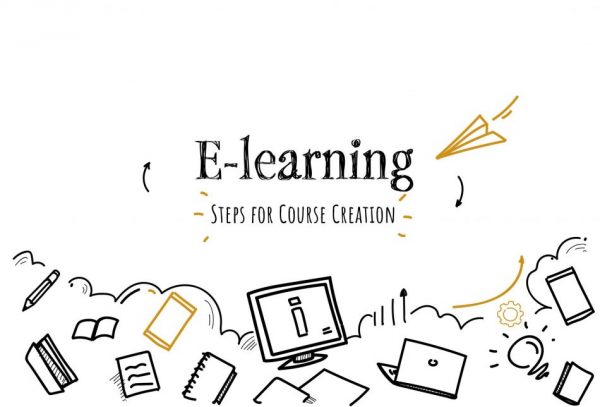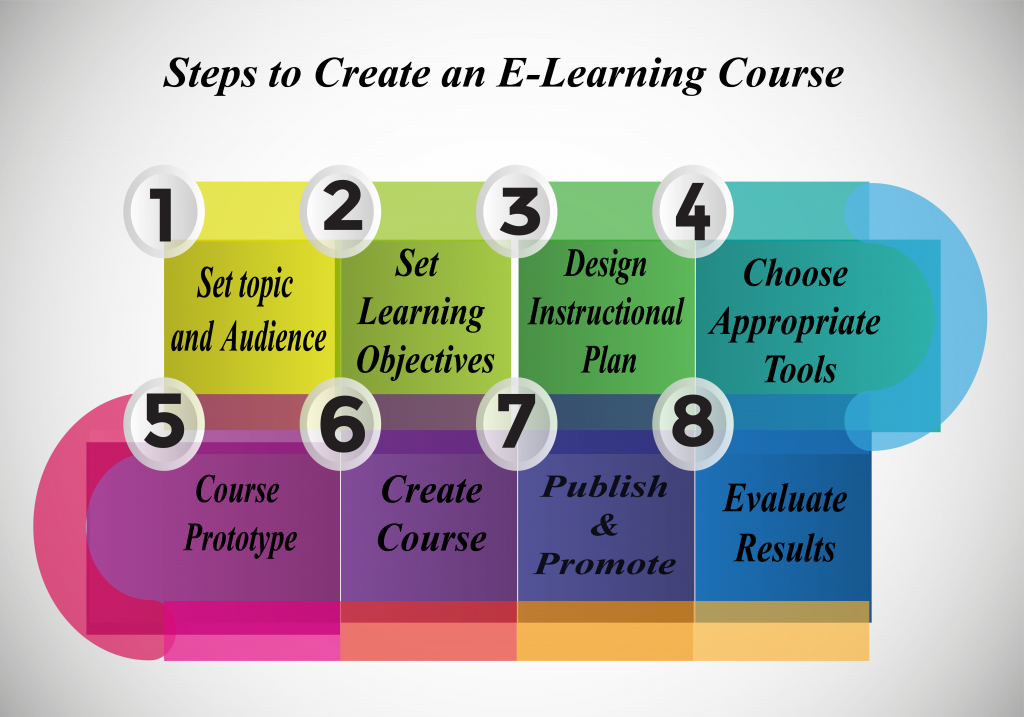eLearning, also known as the modern way of learning, refers to imparting education via electronic media that goes beyond the four walls of a traditional classroom. eLearning courses may be diverse as per the needs of the learners taking the courses but follow a generic framework throughout. Developing these courses is influenced by various factors that are specific to learners’ needs. Content developers argue that the wide accessibility of these courses makes them more customer-specific. The means, circumstances, learning style, learning objective, and so on affect the design of the course. Read further to know more about creating eLearning courses.
What is eLearning?
eLearning is any form of learning that one undertakes on a digital device. Be it an educational video of half an hour or a month-long course on digital marketing, all of it comes under the wide umbrella of eLearning. In other words, one of the reasons why students, professionals, and companies are switching to eLearning courses is their convenience. In the past decade, the online education industry has witnessed a sweeping reorganization in terms of service, user-friendly interface, and availability of downloadable study material. Therefore, considering the demand for online courses, steps for creating eLearning courses count as implicit knowledge.
The Popularity of Online Courses
Today, premier institutions like Harvard University, Penn State University, and the University of Michigan have aligned themselves with the online education sector. Numerous courses offered by these esteemed universities, both paid and free, can be found on EdX, Coursera, and other such platforms. Private corporations such as LinkedIn Learning have enhanced the employability of interns and professionals through their flexible courses on SEO, language courses, Python, C++, animation, and numerous others.
The popularity of online courses is only expected to increase soon as reported by the research conducted by Ambient Insight, which indicates that the global eLearning market is expected to multiply by 5% yearly.
Considering the vast reach of online learning courses, one can independently design modules – a daunting task ultimately made easy in this explanatory blog. Consequently, a step-by-step analysis of the process of creating eLearning courses is summarized below:
Points to Remember while Creating eLearning Courses
1. Analyze the Topic and Set the Audience:
We must note that eLearning typically addresses the gaps in knowledge and helps employees acquire valuable skills. However, it ranks rather low on the scale when a job design plan or a requirement of practical experience is concerned. Companies with dynamic work atmospheres adopt eLearning, and the courses undertaken pertain to product description, code of conduct, software usage, customer satisfaction, and so on. Likewise, retail, banking, and pharmaceutical industries frequently conduct eLearning courses to bring employees up to date with newer requirements on the job.
Knowing the audience allows online course makers to design courses that are relevant, precise, and well-rounded. Surveys, polls, and focus groups within the office or the class generate individual responses about learner expectations from the course, availability, and technical know-how. As a result, this prevents course makers from designing “one-fits-all” modules that leave important gaps in knowledge.
There are several determinants to consider about the target audience before creating eLearning courses:
- Demographics: This involves parameters such as age, educational background, languages spoken, and country of residence.
- Prior Knowledge: An online course may be taken by a small group of learners. Each learner may have varying degrees of prior knowledge. Consequently, an assessment at the beginning of the course is a helpful idea. It informs the designers of specific skills that learners already have. As a result, any and all knowledge gaps are bridged.
- Context: Several psychological and professional factors contextualize a course. Additionally, contextualizing generates maximum learner satisfaction and wide outreach among audiences. Driving questions that help one to decide the context are:
- How much time beyond office/school hours can the learners devote to online learning?
- What are some of the frequent challenges/frustrations in the workplace?
- What are the causes of low productivity, disinterest, or procrastination?
Other factors that help decide the target audiences for creating eLearning courses are learning preferences, group behavior, technical skills, and accessibility.
2. Set the Learning Objectives for the eLearning courses:
To design relevant online courses, it is best to have a comprehensive understanding of learning objectives. Learning deliverables are supposed to fulfill a set of goals by the end of a course. For instance, a statement on the learning objectives of a poetry appreciation course can be –
“By the end of this course, the learner shall be able to critically analyze poetry, measure feet, syllable, and scan for prosodic rhyme. The learner will be able to pinpoint the said text to the specific school of poetry it belongs to.”
This statement at once clarifies the goal(s) of the course for learners to decide whether taking it will benefit them. In the same vein, this set of objectives helps the course maker not stray from the path while designing it.
The SMART mnemonic code helps us to decide on some objectives:
- Specific – specificity of target audience and course outcomes
- Measurable – a variety of means to measure learner progress (tests, quizzes, and peer review)
- Achievable – to ensure that the learning goals are realistic and achievable
- Relevant – the target audience must find the course relevant to their needs.
- Time-bound – can the learners realistically achieve all the teaching goals by the end of the course? The answer decides the necessity of the course.
3. Choose the Appropriate Tools:
The right authoring tools can make or break an online course. The technological know-how of the target audience helps the course maker decide on the tools. For instance, learners with basic technical skills may select an authoring tool with a user-friendly interface and ready templates. On the other hand, a tech-savvy group of learners can adjust to a complex UI, interactive platform, and dynamic simulations. Company budget, software and hardware support, and server maintenance are important factors to consider before selecting the tools.
4. Design an Instructional Plan:
A crucial part of designing an online course is to devise an instructional plan. Most importantly, learners typically do not express interest in a tedious course without audience interaction/participation. At this step, the course maker should consider how to strike a balance between audience engagement and knowledge delivery. Even then we have more to do. The Instructional Plan contains the most effective, engaging, and fruitful method of knowledge dissemination.
If the course deliverable is more fact-based, teachers can represent such knowledge through graphs, charts, and printable study material. However, if the course is about explaining a concept, consider audio-visual content and frequent quizzes to ensure understanding, and encourage e-discussion panels. Instructors may design homework and practice tests in such a manner that they are goal-oriented and evenly spread throughout the course. Above all, coursework should ideally not pile up at the end.
5. Course Prototype:
A task in fine-tuning an online course is prototyping it. Making a prototype entails designing a small-scale version of the course to check its look and feel before launching it formally. This step is a basic simulation task. It checks whether the technical functions are running smoothly, whether the course sequence is correct, and all in all, how promising it looks. Course makers may take the help of other subject matter experts by taking feedback on the prototype before launching it for learners.
6. Create the eLearning Course:
After running a successful prototype that is duly approved, course-makers may take up the task of actually creating the eLearning course. Moreover, one must keep in mind whether the course aligns with the original objectives and take care to design it in a model that enhances learner engagement.
7. Publish and Promote:
After creating an engaging course, contact the marketing team of the said organization to duly promote it. In addition, course makers may promote their work externally through a PR team or adopt an internal promotion plan.
8. Evaluate the Results:
A conscious educator knows that their responsibility extends beyond completing a course; they take learner feedback and measure its effectiveness. In addition, from an end-of-course survey, one may gather valuable tips on how to improve or discern whether the course has delivered on all its objectives.
[Evelyn Learning can help create an eLearning course for you. For more information, click here.]
Creating eLearning Courses: Final Thoughts
To sum up, we have attempted to provide a theoretic guide to creating eLearning courses that are both interactive and engaging. Subsequently, in our next articles on the topic, we shall look into the vast array of eLearning authoring tools on offer today and attempt to draw up a checklist of what makes an effective eLearning course.
References
*Sam S. Adkins. The Worldwide Market for Self-paced eLearning Products and Services: 2010-2015 Forecast and Analysis. July 2011.
Will Erstad. Online By Design. November 2020. Accessed at https://www.rasmussen.edu/student-experience/college-life/quality-online-education-experience/s
For more cues on creating E-Learning courses, visit our blog. Create. Engage. Inspire
















